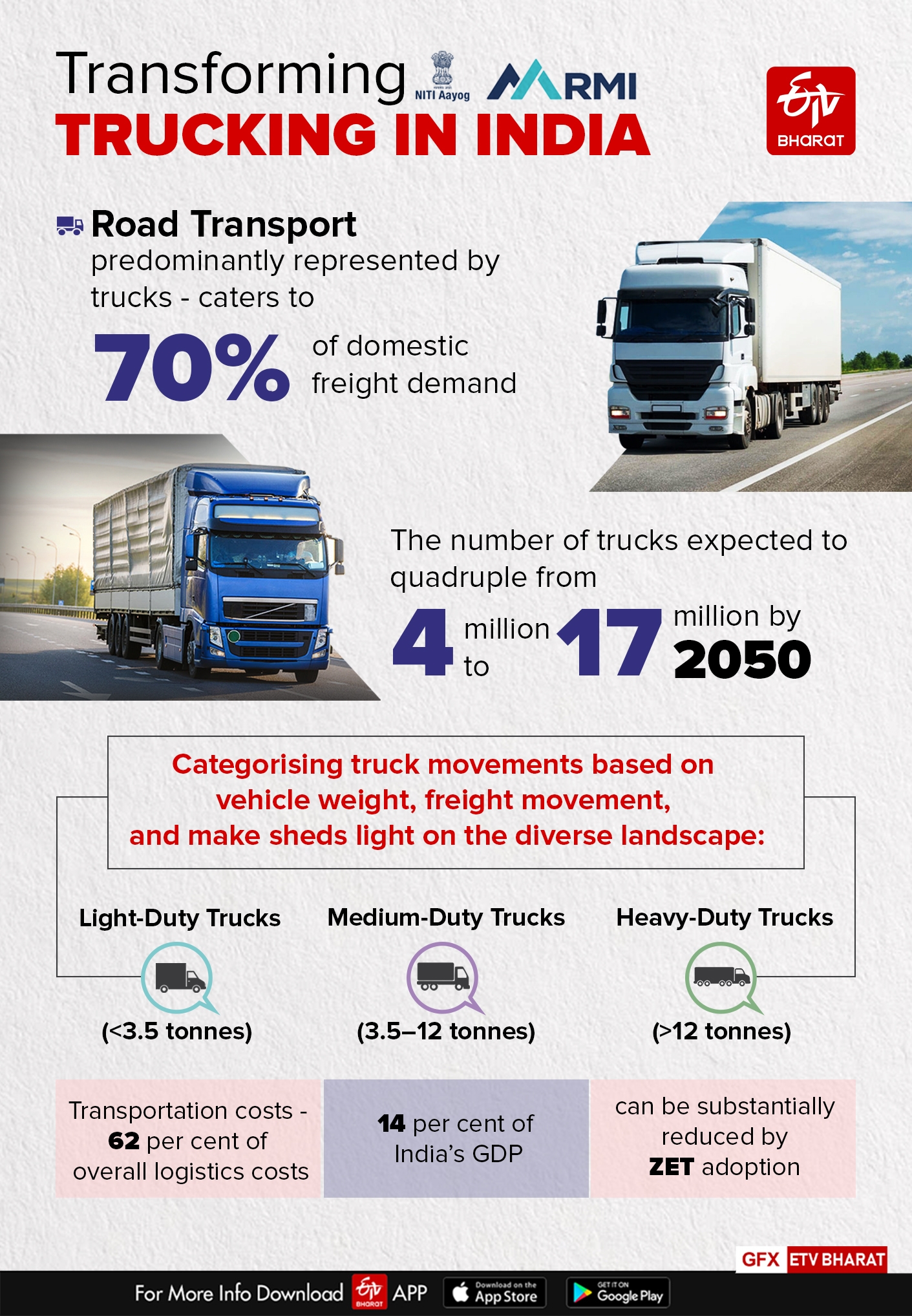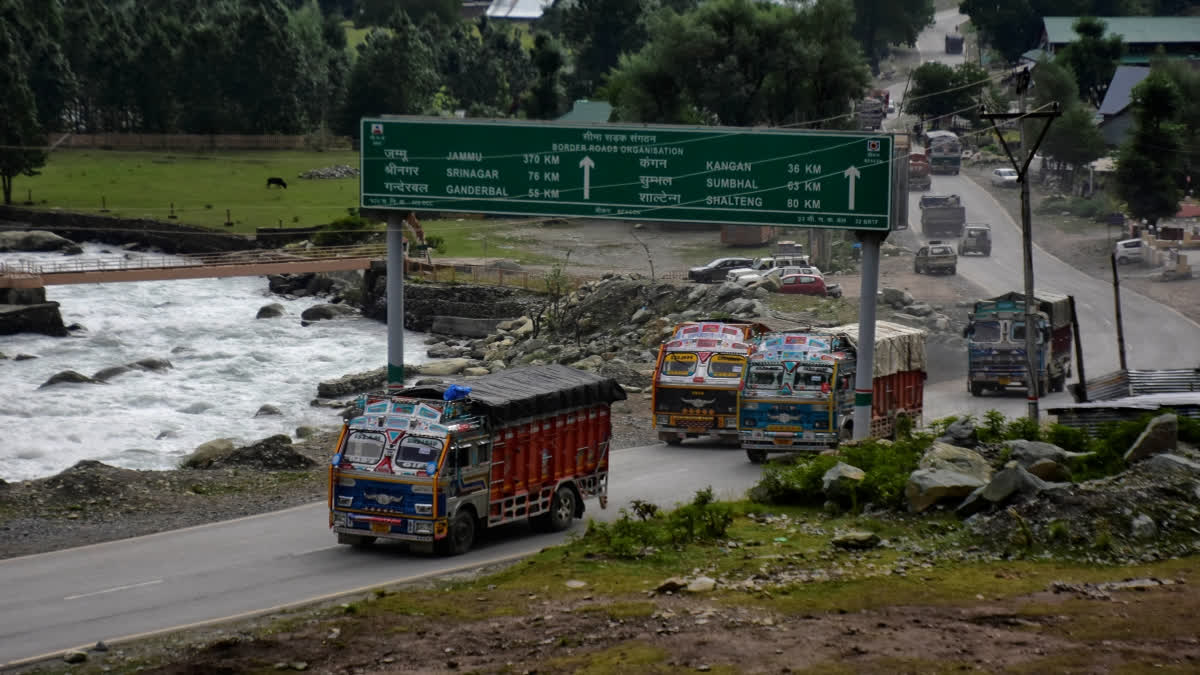Trucks in India bear a substantial environmental burden, contributing significantly to both vehicular CO2 emissions (41%) and particulate matter (PM) emissions (53%). This impact is particularly striking when considering their relatively minimal presence, constituting less than 3 per cent of the total vehicle fleet, inclusive of both passenger and freight vehicles.
Categorising truck movements based on vehicle weight, freight movement, and make sheds light on the diverse landscape: Light-duty trucks (<3.5 tonnes), medium-duty trucks (3.5–12 tonnes), and heavy-duty trucks (>12 tonnes). Despite their pivotal role in the road freight sector, where they consume about 70.5 million tonnes of oil equivalent (Mtoe) and emit 213 Mt of CO2 annually, trucks predominantly rely on Internal Combustion Engine (ICE) vehicles fueled by diesel. Shockingly, less than 1 per cent of the freight vehicles on our roads are electric vehicles (EVs).

Road transport, predominantly represented by trucks, caters to 70 per cent of India’s domestic freight demand. Heavy and medium-duty trucks (HDTs and MDTs) play a crucial role in this, with the number of trucks expected to quadruple from 4 million in 2022 to around 17 million by 2050.
The cost of logistics in India, constituting approximately 14 per cent of the GDP, significantly exceeds that of peer nations (8%-11%). Given the logistics sector's indispensable role, contributing 5% to India's GDP and employing over 22 million people, addressing the environmental impact of trucks is imperative.
However, the electrification of freight vehicles in India faces formidable barriers. Medium and heavy-duty vehicles (MHDVs), with their substantial load capacity, require more power, resulting in an e-truck cost approximately 3–4 times that of a conventional diesel truck. Limited infrastructure, scarcity of models, and financial constraints contribute to the ineffective demand-supply cycle.
India's trucking market, dominated by numerous small operators (about 75% controlling the market with fewer than five trucks), presents both opportunities and challenges for the adoption of zero-emission trucks.
Shifting towards electric trucks necessitates a paradigm change in behaviour among industry players and consumers.
Fostering the widespread adoption of Zero Emission Trucks (ZETs) in India demands a holistic and collaborative approach. Pilot projects can effectively identify on-ground challenges, leading to the development of mechanisms such as risk-sharing, consensus-building, technology advancement, and business case explorations.
Aligning industry efforts with national decarbonization endeavors necessitates a meticulously crafted policy roadmap tailored to India’s unique needs. Additionally, deploying robust charging infrastructure along identified freight-intensive corridors is vital to reduce range anxiety, thereby bolstering the operational confidence of stakeholders.
Skill development and capacity building, spanning various aspects from manufacturing processes to battery handling to comprehensive driver training, are equally vital components. A multi-pronged approach, combining incentivisation with supply-side mandates, aims to transform India's freight industry, contributing to the broader decarbonisation of India's transportation sector.
To pave the way for a more sustainable future in freight operations, it is crucial to enhance awareness, improve financial accessibility, and mitigate the initial capital cost of EVs. Considering the time-sensitive nature of freight operations, the construction of DC fast (50kW) and ultra-fast chargers (100kW or more) is vital to bolster the business case for EVs.
Countries worldwide are utilising policy mechanisms to stimulate a ZET market shift, setting ZET targets and implementing technology advancements. Central and state governments can mitigate investment risks and expand access for ZET purchases through public-backed loans, demand aggregation, interest subvention schemes, and risk-sharing mechanisms.
A notable example is California's adoption of the Advanced Clean Trucks (ACT) Rule. This mandate obliges truck manufacturers to ensure a portion of their annual sales comprises electric trucks, starting in 2024. The target for electric truck sales penetration begins at 6 per cent in 2024, escalating to 63 per cent by 2035, with the ultimate aim of achieving 100 per cent by 2045. Consequently, California anticipates having nearly 5 lakh electric trucks by 2040.
Additionally, on the demand side currently, 50 per cent of India’s vehicle freight traffic travels along seven major corridors connecting Delhi, Mumbai, Chennai, Kandla, Kochi, and Kolkata, presenting an opportunity to strategically invest in charging infrastructure development along these networks to scale ZET adoption.
Transportation costs, comprising 62 per cent of overall logistics costs and 14 per cent of India’s GDP, can be substantially reduced by ZET adoption, leading to a significant economic impact.
The impact of ZETs goes beyond cost reduction. Transportation costs, constituting 62 per cent of overall logistics costs and 14 per cent of India’s GDP, can be significantly lowered through ZET adoption, with diesel fuel costs accounting for the overwhelming majority of transportation costs. ZET adoption could lead to a dramatic 46 per cent reduction in associated fuel costs over a vehicle's lifetime, resulting in broad implications for the Indian economy.
A report from NITI Aayog underscores the potential economic and environmental benefits of embracing clean technologies, including EVs. The report suggests that implementing such technologies could lower India's logistics costs by 4 per cent of the GDP and contribute to a reduction of 10 gigatonnes of CO2 emissions by 2030.
In conclusion, the transformation of India's trucking industry to embrace Zero Emission Trucks represents a crucial step towards achieving environmental sustainability and economic efficiency. The challenges are significant, but a concerted effort involving government policies, industry initiatives, and technological advancements can pave the way for a cleaner, more efficient future. It is not merely a shift in technology but a paradigm change that requires collaboration, innovation, and a shared commitment to a greener tomorrow. The potential benefits, both economic and environmental, are substantial, and the time to act is now.



